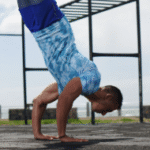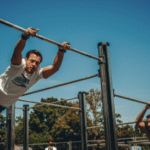Online vs In-Person Private Calisthenics Coaching: Which is Best?
The truth is, there’s no single “best” option – the ideal choice depends entirely on your individual goals, budget, learning style, location, available equipment, and personal preferences. Both formats offer personalized guidance but differ significantly in delivery and experience.
Here’s a detailed comparison across key factors:
**1. Technique Feedback & Correction:**
* **In-Person:**
* **Pro:** Allows for immediate, multi-angle observation by the coach. Crucially, enables **hands-on, tactile cues** (e.g., tapping a muscle that needs activation, gently guiding a limb) which can be incredibly effective for learning complex calisthenics movements and correcting subtle form errors.
* **Con:** Limited to the coach’s physical presence during the session time.
* **Online:**
* **Pro:** Coaches utilize live video feedback, screen sharing for analysis, and potentially client-submitted videos for review between sessions. Allows for recording sessions for later review.
* **Con:** Feedback is entirely dependent on camera angles, video quality, and lighting. Subtle nuances in form might be missed. **No tactile cues possible.** Relies heavily on the coach’s verbal cueing ability and the client’s ability to interpret and apply those cues.
**2. Safety & Spotting:**
* **In-Person:**
* **Pro:** The coach can provide **physical spotting** for challenging or potentially risky exercises like handstands, levers, or learning the negative portion of advanced moves. This provides a crucial safety net and allows clients to push their boundaries more confidently.
* **Con:** Safety still relies on the coach’s attentiveness and spotting skill.
* **Online:**
* **Pro:** Coaches emphasize safe progressions, clear instructions on setup, and teaching self-spotting techniques where applicable.
* **Con:** **No physical spotting is possible.** This inherently increases risk for certain advanced skills or when pushing to failure. Requires greater client self-awareness, potentially modified exercise selection (sticking to progressions where failure is safer), and a safe training environment set up by the client. Might not be suitable for learning very high-risk skills from scratch without any prior experience.
**3. Personalization Level:**
* **In-Person:** Plans are tailored to your goals, abilities, and the equipment available at the training location (gym, park, home). Coach can adapt *instantly* based on visual assessment of fatigue or performance.
* **Online:** Plans are also highly personalized to your goals and abilities, but crucially, they *must* be adapted to the **specific equipment you have available** at your training location. Coaches rely on detailed questionnaires, initial video assessments, and ongoing communication to tailor the plan. Adjustments might happen live or between sessions based on logged results/videos.
**4. Motivation & Accountability:**
* **In-Person:** The act of physically meeting a coach for a scheduled appointment provides strong accountability for many people. Direct encouragement and presence can be highly motivating.
* **Online:** Requires more **self-discipline** from the client to show up, set up tech, and perform the workout. Accountability is maintained through scheduled live sessions (if applicable), regular check-ins via app/messaging, progress tracking, and video submissions. Some find this structure perfectly adequate; others miss the in-person push.
**5. Cost & Value:**
* **In-Person:** Generally **more expensive** per session. Typical rates in the US can range widely from $50 to $150+ per hour, depending on location, coach experience, and facility. This reflects travel time, facility fees, and direct time investment.
* **Online:** Usually **more affordable**. Coaches have lower overhead. Pricing varies: some charge per virtual session (might be ~$75-$100 for an hour that costs $100+ in person), while many offer monthly coaching packages (including programming, check-ins, video feedback) ranging from $100-$500+ per month depending on the level of service and coach’s expertise. You get access to potentially top-tier coaches for less than their in-person rate.
**6. Convenience & Scheduling Flexibility:**
* **In-Person:** Requires commuting to a specific location at a fixed time. Less flexible if your schedule changes frequently.
* **Online:** **Highly convenient and flexible.** Train from anywhere with a good internet connection (home, hotel gym). No commute time saves valuable hours. Easier to fit sessions into busy or irregular schedules, potentially across different time zones.
**7. Access to Coaches:**
* **In-Person:** You are limited to coaches available within a reasonable travel distance in your local area.
* **Online:** Opens up access to a **global pool of calisthenics specialists.** You can find and work with coaches renowned for specific skills (handstands, planche, etc.) regardless of where you both live.
**8. Equipment Requirements:**
* **In-Person:** May utilize the full range of equipment at a gym/studio, or the coach might bring portable items (bands, rings). Less reliance on *your* personal equipment.
* **Online:** Relies **entirely on the equipment you have access to.** The coach must design the program around your specific setup (bodyweight only, pull-up bar, rings, parallettes, weights, etc.).
**9. Coach-Client Connection:**
* **In-Person:** Face-to-face interaction can foster a strong personal connection and rapport more easily for some individuals.
* **Online:** Building rapport happens through video calls and messaging. While very possible and effective for many, some might find it feels less personal than in-person training.
**10. Technology Needs:**
* **In-Person:** Minimal tech needed, mainly for scheduling/communication.
* **Online:** Requires a reliable internet connection, a suitable device (smartphone, tablet, laptop) with a good camera and microphone, potentially a tripod for stable video, adequate lighting, and comfort using video conferencing platforms or training apps. Tech glitches can sometimes interrupt sessions.
**Which is Best *For You*?**
* **Choose In-Person if:**
* You are a complete beginner needing significant hands-on form correction.
* You are working on advanced, high-risk skills requiring physical spotting.
* You highly value face-to-face interaction and tactile cues.
* You have access to and can afford a qualified local coach.
* You prefer training in a gym/studio environment outside your home.
* You are less comfortable or lack reliable technology.
* **Choose Online if:**
* You seek specialized expertise not available locally.
* You need maximum scheduling flexibility and convenience (saving commute time).
* You are budget-conscious (it’s often cheaper).
* You are comfortable with technology and learning via video/verbal cues.
* You are self-motivated and disciplined to train independently based on guidance.
* You have adequate space and equipment at home (or your preferred training location).
* You have some basic exercise experience (often recommended, though not always required).
**Hybrid Option:** Some coaches offer a mix – predominantly online programming with occasional in-person sessions for technique check-ups or hands-on work, offering a blend of benefits.
**Conclusion:**
There is no universally “best” format. Both online and in-person private calisthenics coaching can be highly effective. The optimal choice depends on a careful assessment of your individual goals (beginner fundamentals vs. advanced skills needing spotting), budget, learning preferences (hands-on vs. virtual cues), available resources (local coaches vs. home equipment/tech), and need for convenience versus direct interaction. Consider the pros and cons listed above, and if possible, schedule consultations with both online and in-person coaches to see which approach feels like the better fit for you.

Online vs In-Person Private Calisthenics Coaching: Which is Best?
Route
Calisthenics Gym Houston Functional Bodyweight Training
Secondary phone: (346) 483-3195
Email: info@calisthenicsclubhouston.com
URL: https://calisthenicsclubhouston.com/
Monday 6:00 AM - 7:00 PM Tuesday 6:00 AM - 7:00 PM Wednesday 6:00 AM - 7:00 PM Thursday 6:00 AM - 7:00 PM Friday 12:00 PM - 6:30 PM Saturday 9:45 AM - 12:00 PM Sunday 3:00 PM - 5:00 PM





